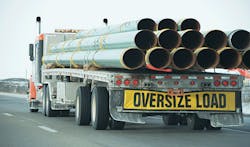Construction Worker Killed When Pipe Rolls Off a Trailer
Construction worker David Earl Hyde was killed Feb. 20 when a large metal pipe rolled off a trailer and struck him.
According to the state patrol, the 38-year-old Missouri man was assisting in the unloading of large metal pipes from a trailer when a pipe weighing as much as 2,500 pounds landed on him. They said that Hyde died at the scene.
In a statement, Ames, the contractor on the project, acknowledged “the worker was delivering pipe to the project and a section of pipe may have rolled off the delivery truck when the worker unstrapped it.”
The statement noted that workers at the site offered first aid to Hyde until paramedics arrived and transported him to the hospital.
The Minnesota Occupational Safety and Health Administration is investigating the incident, which is eerily similar to one that occurred in October 2016 which also is under investigation, according to an article in Finance and Commerce. In that incident, a truck driver was struck and killed by a pipe that fell off a trailer. The driver and a forklift operator were unloading pipes from the flatbed trailer, and the truck driver had been loosening the straps that were holding the pipes. That case remains open.
Minnesota Worker Fatality Rates Increased
A total of 74 fatal work-injuries were recorded in Minnesota in 2015 (the most recent year for which final statistics are available. Minnesota’s 2015 fatal injury rate is 2.7 fatalities per 100,000 full-time-equivalent workers; the 2014 rate was 2.3 fatalities per 100,000 full-time-equivalent workers.
- Agriculture, forestry, fishing and hunting recorded the highest number of worker fatalities in Minnesota, with 23 cases, an increase from 21 cases in 2014. The fatal injury rate in this industry sector is 16.9 fatalities per 100,000 full-time-equivalent workers.
- Construction had the second-highest number of fatalities, with nine cases, compared to seven cases in 2014. The fatal injury rate in this industry sector is 5.0 fatalities per 100,000 full-time-equivalent workers.
- Manufacturing and administrative and waste services each had seven fatally injured workers, the third-highest counts.
Contact with objects and equipment was the second most-frequent fatal work-injury event in 2015 after transportation incidents, with 17 fatalities. Most of these cases involved the worker being struck by an object or equipment. There were 14 fatalities cause by contact with objects and equipment in 2014.
Men accounted for 60 of the 74 fatally injured workers in 2015. The 14 fatally injured female workers was the highest CFOI count in Minnesota since the inception of the program in 1992.
About the Author

Sandy Smith
Sandy Smith is the former content director of EHS Today, and is currently the EHSQ content & community lead at Intelex Technologies Inc. She has written about occupational safety and health and environmental issues since 1990.
